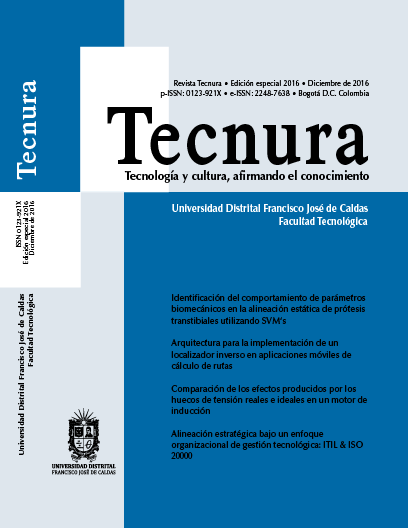DOI:
https://doi.org/10.14483/22487638.11677Publicado:
04-03-2017Número:
Vol. 20 (2016): Edición EspecialSección:
InvestigaciónIdentificación del comportamiento de parámetros biomecánicos en la alineación estática de prótesis transtibiales utilizando SVM'S
Identification of biomechanical parameters in the static alignment of transtibial prosthesis using SVM´S
Palabras clave:
lineación estática, Amputación, Máquinas de Soporte Vectorial, Transtibial. (es).Palabras clave:
Static alignment, Amputation, SVM, Transtibial. (en).Descargas
Resumen (es)
Contexto: A nivel mundial se conocen como “amputados transtibiales” los amputados de segmento corporal por debajo de rodilla. La amputación tiene diversas causas, puede deberse a enfermedades del sistema vascular periférico, o lesiones tumorales como el cáncer, o a la ausencia o deficiencia congénita, o a traumatismos sufridos por accidentes, entre los que se tienen las minas antipersona. Hasta agosto de 2016 se calculan cerca de 10.000 víctimas de minas antipersona, y entre estas víctimas hay quienes tienen amputaciones transtibiales. Teniendo en cuenta que el método más utilizado para la rehabilitación del amputado es la prótesis, la adaptación protésica requiere de procesos y procedimientos, algunos generalizados como la alineación de la prótesis. Es importante conocer la afectación de los parámetros biomecánicos en la alineación.
Método: En esta investigación se planteó predecir y explicar los patrones de los parámetros biomecánicos de ángulos de las articulaciones de segmentos corporales inferiores, el centro de de presión (COP) y y la distribución de peso en los amputados transtibiales durante la alineación estática. Se desarrolló un modelo computacional haciendo uso de Máquinas de Soporte Vectorial (SVM’s, por su siglas en inglés) de alineación transtibial durante bipedestación estática. Por otro lado, para tener los datos de alimentación del modelo, se realizó un estudio descriptivo transversal en el Hospital Militar Central en Bogotá, Colombia, donde se varió la ubicación angular sagital del encaje (socket, por sus siglas en inglés) de la prótesis y se midieron los parámetros. Un sujeto masculino con una amputación transtibial se ofreció como voluntario para el estudio. Al sujeto se le realizaron pruebas en tres ocasiones separadas a intervalos de dos días. La prótesis se alineó para estar en posición óptima para el sujeto y luego se cambió en +2°, +4°,+ 6º, -2°, -4° y -6º en el plano sagital.
Los datos cinemáticos y cinéticos se registraron simultáneamente mediante un análisis de posición de bipedestación estática. Los datos del ángulo del encaje de la prótesis fueron introducidos en un modelo de la alineación transtibial y los datos cinemáticos y cinéticos fueron predichos por el modelo computacional. La ubicación sagital del encaje fue la variable de entrada y las variables de salida fueron los parámetros biomecánicos. Se comprobó el desempeño del modelo con la correlación entre los datos suministrados por el modelo y la base de datos original.
Resultados: Los datos recogidos en las mediciones permitieron generar una base de datos, y el análisis muestra que la distribución de los datos difiere para cada ubicación del socket. Se generó un modelo computacional que reproduce los hallazgos obtenidos en el estudio, y presenta un error inferior al 10%.
Conclusiones: La alineación adecuada de la prótesis es muy importante para las actividades normales del sujeto. La ubicación angular en flexo-extensión del socket incide en los rangos articulares de segmento de miembro inferior y ubicación del centro de presión, principalmente. El bajo error que presenta el modelo permite concluir que la máquina de soporte vectorial es un algoritmo de buen desempeño en el estudio de la alineación de prótesis; asimismo, las variables elegidas son adecuadas en la predicción de la alineación
Resumen (en)
Context: The body segment amputees below the knee are globally known as “transtibial amputees”. Diseases of the peripheral vascular system, or tumor lesions such as cancer, or the absence or congenital deficiency, or trauma suffered by accidents (including antipersonnel mines) can cause amputation. Until August 2016, the Presidential Program for Integral Action against Mines, a unit of the Administrative Department of the Presidency of the Republic, reports about 10.000 victims of antipersonnel mines, including transtibial amputations. Considering that the most widely used method for amputee rehabilitation is the prosthesis, prosthetic adaptation requires some generalized procedures, such as the alignment of the prosthesis, and it is important to know the affectation of the biomechanical parameters in such alignment.
Mhetod: In this research we plan to predict and explain the patterns of biomechanical parameters of lower body segment joints angles, Pressure Center (COP) and weight distribution in transtibial amputees during static alignment. We developed a computational model using Vector Support Machines (VSMs) of transtibial alignment during static biped. On the other hand, in order to have the feeding data of the model, we performed a cross-sectional descriptive study at the Central Military Hospital in Bogotá, Colombia, where we varied the sagittal angular location of the prosthesis socket and measured the parameters. A male subject with a transtibial amputation volunteered for the study. The subject was tested on three separate occasions at two-day intervals. The prosthesis was aligned to be in optimal position for the subject and then changed into + 2 °, + 4 °, + 6 °, -2 °, -4 ° and -6 ° in the sagittal plane.
We recorded the kinematic and kinetic data simultaneously by means of a static biped stationary position analysis. We introduced the prosthesis fitting angle data into a transtibial alignment model, and the computational model predicted kinematic and kinetic data. The sagittal location of the lace was the input variable and the bieomechanical parameters, the output variables. We also verified the performance of the model with the correlation between the data supplied by the model and the original database.
Results: The data collected in the measurements allowed to generate a database, and the analysis shows that the distribution of the data differs for each location of the fit. We generated a computational model that reproduces the findings obtained in the study, and presents an error lower than 10%.
Conclusion: Adequate alignment of the prosthesis is very important for the subject’s normal activities. The angular location in flexo-extension of the socket affects the articular ranges of lower limb segment and location of the center of pressure, mainly. The low error presented by the model allows concluding that the vector support machine is a good performance algorithm in the study of prosthesis alignment; also, the chosen variables are adequate in the prediction of the alignment.
Referencias
Amputee Coalition of America. (2004). Atletas Paralimpicos: Equipados para el Futuro. INMOTION.
Amputee Coalition of America. (2005). Alternativas para la suspensión tibial; Military step. EEUU.
Amputee Coalition of America. (2016, 02 11). Retrieved from http://www.amputee-coalition.org/
Biometrics LTDA. (2016, 2 2). Reino Unido. (Biometrics Ltd) Retrieved from http://www.biometricsltd.com/
Blumentritt. (1997). New biomechanical method for determination of static prosthetic alignment. Prosthetics and Orthotics International. Department of Research, Otto Bock Orthopaedic Industry, Duderstadt, Germany., 21, 107-113.
Boston, T. (1, 2 2016). Barefoot Pressure Measurement Systems. Retrieved from http://www.tekscan.com/barefoot-pressure-measurement-systems
Castellanos, C. A. (2015). Modelamiento de la Marcha Humana con prótesis de Miembro Inferior Mediante Herramientas de Simulación Dinamica (Una Aplicación en OPENSIM). Bogota-Colombia: Universidad Nacional de Colombia-SEDE BOGOTA-.
Dirección Contra las Minas. (2016, 02 04). Retrieved from http://www.accioncontraminas.gov.co/estadisticas/Paginas/victimas-minas-antipersonal.
Dolado, J. (1998). Gennetic Programing, Neural Network and Linear Regresión in software Project Estimation. University of the Basque Country, 157-170.
Joachims, T. (2016, 02 04). SVM. (University of Dortmund ) Retrieved from http://svmlight.joachims.org/
Kernel machines. (2016, 04 02). kernel machines. Retrieved from http://www.kernel-machines.org/
Lannon, N. (2003). Alineación Transtibial. Alineación de banco normal, 12-14.
Alpaydın, E. (2014). Introduction to machine learning (Vol. 1107). MIT. http://doi.org/10.1007/978-1-62703-748-8-7
Fernie, G. (1981). Biomechanics of Gait and Prosthetic Alignment. In J. P. Kostuik (Ed.), Amputation surgery and rehabilitation. The Toronto experience (p. 448). New York: Churchill Livingstone. http://doi.org/10.1016/0020-1383(84)90022-6
García, V., Núñez, E., Espada, J., Pelayo, C., Cueva, J., & Montenegro, C. (2014). A brief introduction to model-driven engineering. Revista Tecnura, 18(40), 127–142. http://doi.org/http://dx.doi.org/10.14483/udistrital.jour.tecnura.2014.2.a10
Hannah, R. E., Morrison, J. B., & Chapman, A. E. (1984). Prostheses alignment: effect on gait of persons with below-knee amputations. Archives of Physical Medicine and Rehabilitation, 65(4), 159–162.
Luengas, L. A., Camargo, E., & Sánchez, G. (2013). Estudio de los rangos articulares en la bipedestación estática en personas normales vs . Amputados transtibiales. Tecnura, 17, 60–68.
Luengas, L. A., Gutierrez, M. A., & Camargo, E. (2014). Estudio de fuerzas en la bipedestación estática. Visión Electrónica.
Murphy, E. (1954). The fitting of below knee prostheses. In P. E. Klopsteg & P. D. Wilson (Eds.), Human limbs and their substitutes (pp. 693–702). NewYork: McGraw-Hill.
Novel.de. (n.d.). The pedar® system. Retrieved May 11, 2014, from http://www.novel.de/novelcontent/pedar
Pinzur, M. S., Cox, W., Kaiser, J., Morris, T., Patwardhan, A., & Vrbos, L. (1995). The effect of prosthetic alignment on relative limb loading in persons with trans-tibial amputation: a preliminary report. Journal Of Rehabilitation Research And Development, 32(4), 373–378. Retrieved from http://www.ncbi.nlm.nih.gov/entrez/query.fcgi?cmd=Retrieve&db=PubMed&dopt=Citation&list_uids=8770802
Pyle, D. (1999). Data preparation for data mining. Morgan Kaufmann Publishers, Inc. San Francisco: Morgan Kaufmann Publishers, Inc. http://doi.org/10.1080/713827180
Rairán, J. (2012). Definición de un controlador basado en emociones para sistemas dinámicos. Revista Tecnura, 16(33), 12–22. http://doi.org/http://dx.doi.org/10.14483/udistrital.jour.tecnura.2012.3.a01
Wilson, B., Pritham, C., & Cook, T. (1979). A force-line visualization system. Prosthetics and Orthotics International, 3(2), 85–7. Retrieved from http://www.ncbi.nlm.nih.gov/pubmed/503798
Zahedi, M. S., Spence, W. D., Solomonidis, S. E., & Paul, J. P. (1986). Alignment of lower-limb prostheses. Journal of Rehabilitation Research and Development, 23(2), 2–19. Retrieved from http://www.ncbi.nlm.nih.gov/pubmed/3724127
Ottobock. (2016, 02 08). Elección del encaje, diferentes modos de suspensión y la importancia del alineamiento. Retrieved from http://www.ortomedicalcare.com/docs/ponencias/ponencias2010/ponencia6.pdf
Salgado, S. S. (2012). Alineación en Prótesis de Miembro Inferior por Encima de Rodilla. Envigado: EIA.
Cómo citar
APA
ACM
ACS
ABNT
Chicago
Harvard
IEEE
MLA
Turabian
Vancouver
Descargar cita
Licencia
Esta licencia permite a otros remezclar, adaptar y desarrollar su trabajo incluso con fines comerciales, siempre que le den crédito y concedan licencias para sus nuevas creaciones bajo los mismos términos. Esta licencia a menudo se compara con las licencias de software libre y de código abierto “copyleft”. Todos los trabajos nuevos basados en el tuyo tendrán la misma licencia, por lo que cualquier derivado también permitirá el uso comercial. Esta es la licencia utilizada por Wikipedia y se recomienda para materiales que se beneficiarían al incorporar contenido de Wikipedia y proyectos con licencias similares.


